 In that our post about the earth carvings (the Cuscans have nothing on us) at Second and Hill garnered some interest, I thought it worthwhile to detail salient features and goings-on sundry of other buildings on the block.
In that our post about the earth carvings (the Cuscans have nothing on us) at Second and Hill garnered some interest, I thought it worthwhile to detail salient features and goings-on sundry of other buildings on the block.
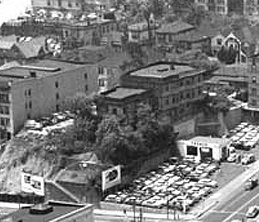
One notable structure looming over Hill was the El Moro. The Sanborn Maps in the Dirt Patch post show us the house at 109 South Hill was built between 1888 and 1894. This was the home of prominent Los Angeles druggist, and President of Western Wholesale Drug Company, Howard M. Sale, who had arrived from Pueblo, Colorado in 1886. Mr. and Mrs. Sale built Castle Crag in 1888 but decided Bunker Hill was the proper place to be, so sold out in ’89 to build 109 South Hill. This house on the bluff was a center of Society for some years before Mr. and Mrs. Sale decided to turn it into a hotel in 1901 (moving into a larger house at Ninth and Union in 1902).
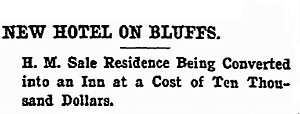

With the Sale‘s three-story addition to the now-named El Moro, the structure extended back 133 feet and included a total of thirty-five rooms.

The El Moro‘s location, some 150‘ above the sidewalk, made firefighting a little tricky, which aided in a near-total loss of the front portion of the mansion in January 1914. There were thousands of spectators at the scene, and whether they turned out for the dramatic blaze or the sight of sixty some-odd guests in an early-morning state of deshabille is a matter of conjecture.
 Not a lot of Postwar noirisme at the El Moro, if you‘re after that sort of thing. Mrs. Mollie Lahiff, 50, died of (what the papers termed) accidental asphyxiation after a gas heater used up all the oxygen in her tightly sealed room, February 26, 1953. Should you be so inclined, consider how drafty these places tend to be. Tightly sealed takes some doing. Just saying.
Not a lot of Postwar noirisme at the El Moro, if you‘re after that sort of thing. Mrs. Mollie Lahiff, 50, died of (what the papers termed) accidental asphyxiation after a gas heater used up all the oxygen in her tightly sealed room, February 26, 1953. Should you be so inclined, consider how drafty these places tend to be. Tightly sealed takes some doing. Just saying.
And now, for your edification and delectation, the unhappy end of a streetcar just below the El Moro, 1937.
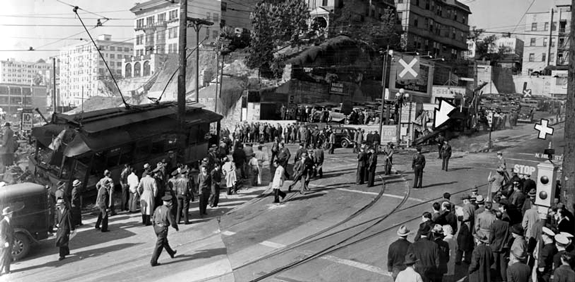


132/134 South Olive is one of the oldest stuctures on the block, dating to before ’88. Here’s a shot of the H-shaped building, next to our old pal, the Argyle.
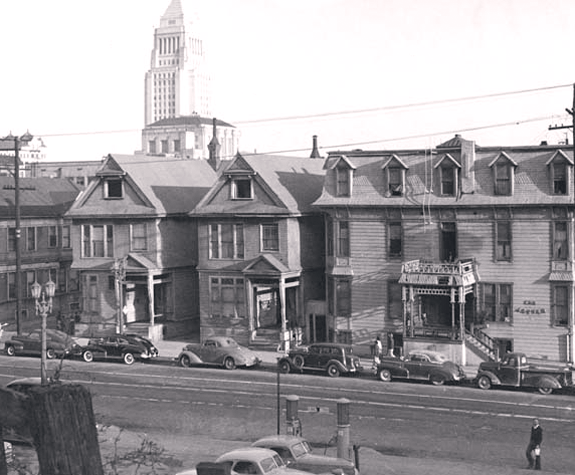
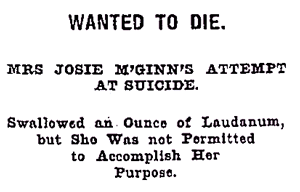
January 24, 1895. Mrs. Josie McGinn, a widow of 28 with a well-grown girl of 10, was sitting with her stepsister Grace in their home at 134 (in the image above, the one on the right), and Josie mentioned she was feeling poorly. Grace suggested a walk. At the foot of the terrace steps on Broadway Josie complained of feeling weak, but they continued down Franklin nonetheless. When they hit New High Street, Josie collapsed altogether. When asked what her trouble was, Josie replied, “I have taken laudanum.” She was taken to Receiving Hospital, where her life was saved, and there explained that while she was fixing her hair at the bureau in preparation for the walk downtown, there sat her glycerine and laudanum–intended for her ear condition–and in a moment of impulsive despair drank the laudanum. Such is the torment of modernity.
 A favorite phrase of Edwardian Angeles is “sneak thief,” and Bunker Hill sneak thieves were forever securing some silver coinage here and a jeweled stick-pin there; on August 17, 1903, for example, during Mrs. H. Ware‘s temporary absence from 132, a sneak thief entered and stole $10 and a gold watch (a similar burglary occurred that same day, where at 104 S. Olive a room occupied by Mrs. Case was ransacked and liberated of $20).
A favorite phrase of Edwardian Angeles is “sneak thief,” and Bunker Hill sneak thieves were forever securing some silver coinage here and a jeweled stick-pin there; on August 17, 1903, for example, during Mrs. H. Ware‘s temporary absence from 132, a sneak thief entered and stole $10 and a gold watch (a similar burglary occurred that same day, where at 104 S. Olive a room occupied by Mrs. Case was ransacked and liberated of $20).
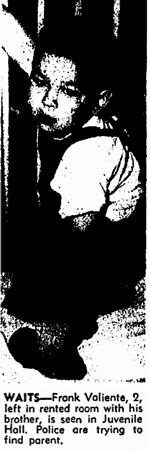
Mrs. Frances Valiente, about 25, lived in 132 with her two boys, Frankie, about 2, and a one year-old infant, unnamed. Frances went out one Friday night in April of 1951 and didn‘t elect to return. Frank went to Juvie and the infant to the nursery at General.
 July 30, 1954. Jesus Chaffino is a 2 year-old with a talent for opening doors. Apparently his mother, Maria Avila, didn‘t tell her sister-in-law that when she left her place at 121 North Hope and dropped of the Jesus at 132 S. Olive. He was turned over to juvenile officers when he was found wandering near First and Olive at five a.m.
July 30, 1954. Jesus Chaffino is a 2 year-old with a talent for opening doors. Apparently his mother, Maria Avila, didn‘t tell her sister-in-law that when she left her place at 121 North Hope and dropped of the Jesus at 132 S. Olive. He was turned over to juvenile officers when he was found wandering near First and Olive at five a.m.
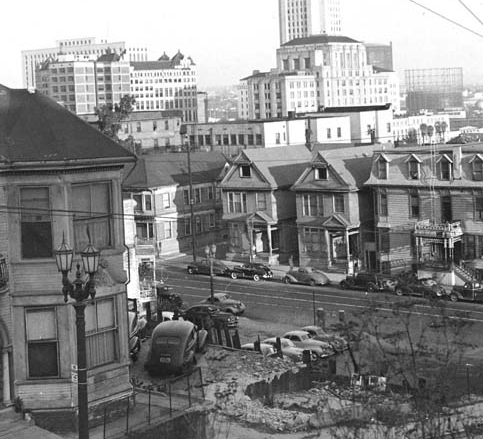
Let’s cast an eye on the buildings around the block from the Argyle down Second (the $1.50/day and weekly rates on your left is the Northern):
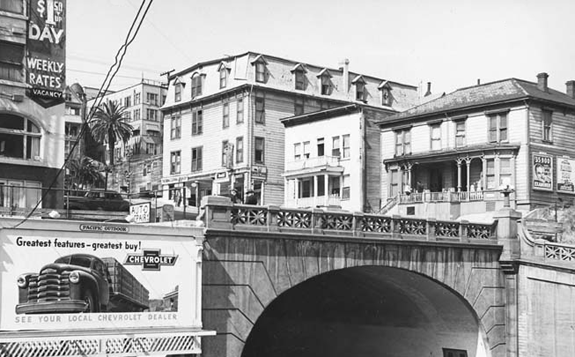
In a shot obiviously taken from the Northern, we have the Argyle on our left, 425 West Second center, and 421/419 West Second on the right. (Olive Street stretches away north, left; the Moore Cliff with El Moro behind are upper right; the pile of dirt in back is where they’d put the court house.)
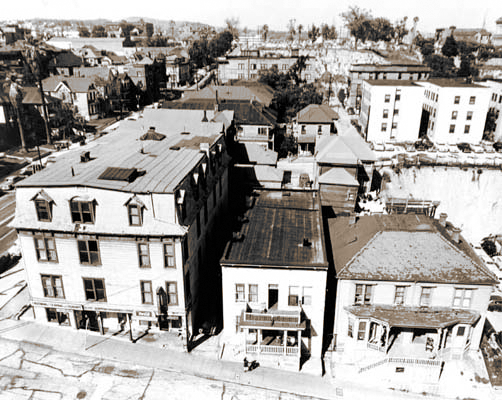
![]() Sneak thiefs! enter 425 in 1902 and make off with a stand cover and a fine wall picture. Is nothing sacred? The answer is no. Not to the sneak thief.
Sneak thiefs! enter 425 in 1902 and make off with a stand cover and a fine wall picture. Is nothing sacred? The answer is no. Not to the sneak thief.
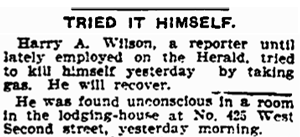
Harry Wilson was an actor who decided to take up newspaper work. He was assigned to the police news, was as such often exposed to suicides down at Receiving Hospital. This, it is thought, had a disturbing, destabilizing influence on his mind; Harry left a note for his wife on what he thought was going to be the last day of his life, October 8, 1904, and with that took the gas-pipe in their apartment in 425. He survived, and with luck returned to neither tread board nor sling ink.
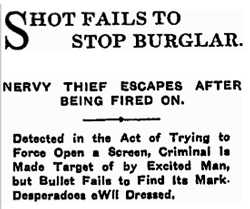 July 16, 1907. A burglar was detected working the window at Mrs. M. M. Clay‘s apartment house, 425, by her daughter, Clara Clay. She exclaimed under her breath to a Mr. Charles See, who kept the apartment above hers, “There‘s a man trying my window.”
July 16, 1907. A burglar was detected working the window at Mrs. M. M. Clay‘s apartment house, 425, by her daughter, Clara Clay. She exclaimed under her breath to a Mr. Charles See, who kept the apartment above hers, “There‘s a man trying my window.”
So See fetched his revolver and leaned out the upper story and commanded the man to hold up his hands. With a great bound the man leapt over a tall fence some four feet away, while See fired and missed. The burglar, well-dressed and polite as could be, broke through the back screen door at the adjoining apartment house at 421, strode lightly through the hall; he tipped his hat to a young lady in the hall and she replied “Good evening.” He stepped out on to the front porch where several roomers were sitting. He bade them all a good evening and, tipping his hat, walked slowly down the street. Moments later it was Charles See, feverish and gun-waving, who threw terror into the hearts of the tenants.

July 22, 1924. Roy Shellington called 425 home, or at least he did until Federal prohibition officers noticed he was overly cautious in handling his suitcase while little doggies nipped at his heels. Shellington bunked in the hoosegow after the Feds found twelve bottles of Scotch inside, verboten in Volstead America.
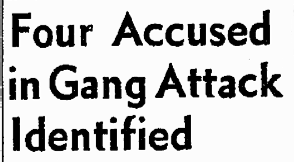
Alex Markovich, 33, lived at 425, but had the misfortune of making his way down to Third and Spring on December 28, 1953. There he was jumped and beaten by hoodlums Alphonso Ruiz, Ramon Zaavedra, Gilbert Garcia, and”¦Mrs. Eleanor Talkington. Luckily, while Markovich was in critical condition at General with a basal skull fracture, the perps were charged with suspicion of robbery and ADW after having been ID‘d by eyewitnesses, who were none other than Joaquin Aquilar Robles, former Police Chief of Tijuana, and Rafael Estrada, ex-Mayor of Ensenada.
Not much to tell about 421/419, other than recommending one leap upon well-dressed gents tipping their hats with a “good evening,” as they‘re bound to be window-pryers from next door. Another piece of good advice is that once you‘ve checked in, it‘s best to never set foot outside again. Especially if you‘re an elderly gentleman. On November 4, 1944, ![]() Mattie Mitchell, 70, departed his apartment at 421 and was run down by an LA Railway streetcar at Fifth and Hope. Joseph Erolet, a 77 year-old news vender ventured outside of 421 on May 23, 1946, and was clobbered by an auto at Brand and Wilson in Glendale.
Mattie Mitchell, 70, departed his apartment at 421 and was run down by an LA Railway streetcar at Fifth and Hope. Joseph Erolet, a 77 year-old news vender ventured outside of 421 on May 23, 1946, and was clobbered by an auto at Brand and Wilson in Glendale.
And so concludes today‘s report from this block, and the particular concavity that spawned the ongoing completist account of its whats and wherefores.
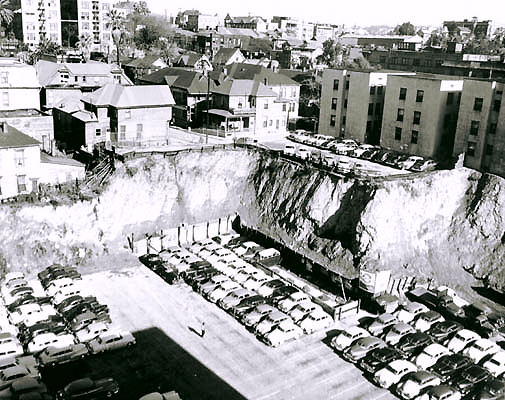

Images courtesy the Los Angeles Public Library Photo Collection and the Arnold Hylen Collection, California History Section, California State Library

